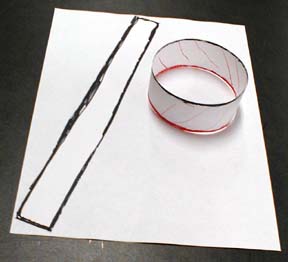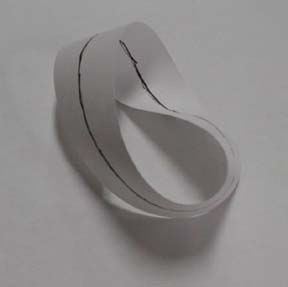A Mobius strip is a band of paper that's deceptively simple in its appearance and exceptionally twisted in its properties.

A Mobius strip is a band of paper that's deceptively simple in its appearance and exceptionally twisted in its properties.

Introduction
The properties of a twisted strip of paper depend a great deal on the number of times it is twisted. Counting the twists is an interesting exercise that illustrates Paul's first mathematical principle,"Counting is difficult."
Material
Part 1 Warming up
To Do and Notice
Look at your the strip of paper.
Count the edges: Start coloring an edge at one point with your pen, if you color the entire edge and never have to lift the pen from the paper then the paper has one edge. A pointy vertex does not divide an edge into two parts.
Count the sides: Start coloring one side, fill it with color but don't cross over any sharp edges. When you are done, one side will be colored the other will not. So, the strip has 2 sides.
A simpler way to test for the number of sides is to draw a line along one side. If any point can be reached from the line without crossing an edge then that point is on the same side as the line. Draw a line on one side of the paper, points on the other side cannot be reached without crossing an edge, this means the paper has two sides.
Make the paper into a loop with no twists. Notice that it still has 2 sides but that now it has two edges.

Make a Mobius Strip
Give the paper a half twist and tape or glue the ends together to make a twisted loop.
Count the number of faces on the paper by using the pen to draw a line along the middle of the strip of paper. Notice that the line returns to its start without ever crossing an edge. You can reach every point on the strip from the line, therefore the Mobius strip has only one side. Count the number of edges.

Try giving loops different numbers of half twists see if you can find the rule connecting the number of half twists and the number of sides.
Be careful, counting, as I like to point out, isn't as easy as your first grade teacher led you to believe. It's difficult to count the number of sides to a piece of paper even though the number is either 1 or 2.
What's Going On?
The Mobius strip has one side and one edge.
Loops with an odd number of half-twists have one
side and one edge,
loops with an even number have two sides and two edges.
Tools for Further Study
Counting the number of half twists can be a difficult problem.
But you need to know the number.
Try the following, Hold the twisted strip with one hand pulling down on the bottom and the other hand on the top.
Hold it so that on one side of your two hands there are no twists. All the twists will be on the other side.
Twist the top of the Mobius strip to unwind the twists on one side of your hands and move them to the originally untwisted side.
Count the number of half-twists it takes to completely remove all of the twists from one side of the strip.
Going Further
Go to Mobius Dissection. You'll cut twisted strips in half and then count their sides and twists.
Etc
In 1858, mathematician August Ferdinand Mobius discovered the peculiar properties of this paper loop. Ever since, topologists (a specially twisted breed of mathematician) have been experimenting and speculating about the properties of this strip and its relatives.
Reference
See the article Twisted Thinking by Paul Doherty and Pat Murphy from the Magazine of Fantasy and Science Fiction.
|
Scientific Explorations with Paul Doherty |
|
20 October 2000 |